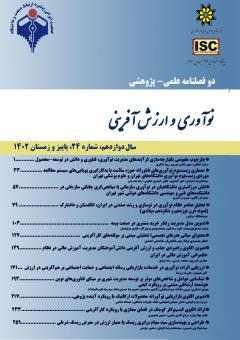چارچوب مفهومی یکپارچه سازی فرآیندهای مدیریت نوآوری، فناوری و دانش در توسعه محصول
محورهای موضوعی : عمومى
سمیرا شقاقی
1
![]() ,
سپهر قاضی نوری
2
*
,
رویا شاکری
3
,
سپهر قاضی نوری
2
*
,
رویا شاکری
3
1 - گروه مدیریت، واحد سنندج، دانشگاه آزاد اسلامی، سنندج، ایران
2 - استاد گروه مدیریت فناوری اطلاعات، دانشگاه تربیت مدرس، تهران، ایران
3 - استادیار دانشکده مدیریت، دانشگاه آزاد اسلامی واحد سنندج، کردستان، ایران
کلید واژه: مدیریت نوآوری, مدیریت فناوری, مدیریت دانش, فرآیند توسعه محصول, یکپارچه سازی,
چکیده مقاله :
پديدار شدن اقتصاد دانش بنيان و به تبع آن، افزايش اهميت مقولاتي چون دانش، نوآوري و فناوري موجب افزايش تمركز بر مفاهيمي چون مديريت دانش، مديريت فناوري و مديريت نوآوري شده است. این مقاله به بررسی مقالات موجود و پژوهشهایی که در رابطه با یکپارچه¬شدن سه حوزه مدیریت دانش، نوآوری و فناوری صورت گرفته است میپردازد تا یک مدل مفهومی برای یکپارچه کردن این سه حوزه ارائه کند که ضمن پوشش ويژگيهاي هر يك از اين مديريت¬ها، از اتلاف منابع سازماني ناشي از همپوشاني مديريت دانش، نوآوري و فناوري و تقابل آنها با يكديگر جلوگيري شود. ابتدا یک مرور ادبیات سیستماتیک انجام شد که در آن طیف وسیعی از مقالات مرتبط از سال 1980 تا 2021 جستجو گردید. سپس از روش فراترکیب استفاده شد تا یافتههای حاصل از پژوهشهای پیشین کدگذاری شده و با یکدیگر ترکیب شود. در این مرحله برای سهولت کار از نرمافزارهای Perish و MAXQDA برای کدگذاری استفاده شد. در این بررسی بالغ بر 220 کد به واحدهای داده تخصیص داده شد. سپس 220 کد تحلیل و کدهای مشابه تجمیع شدند. در نهایت 24 کد که کدهای پایه نامیده شدند حاصل شد. در مرحله بعدی مضامین پایه دسته بندی و پنج مضمون سازماندهنده زیر استخراج گردید: اصول مدیریت نوآوری – دانش، توانمندسازهای مدیریت نوآوری – دانش، روال سازی و ایجاد فرهنگ یکپارچگی، زیرساخت یکپارچه سازی، مکانیسم های یکپارچه سازی. در نهایت، یک مدل مفهومی پیشنهاد میشود که ارتباط این حوزهها با یکدیگر و نحوه تعامل و همپوشانی و راهکارهایی برای یکپارچه کردن آنها را تشریح می¬نماید
The emergence of the knowledge-based economy and, as a result, the increase in the importance of categories such as knowledge, innovation, and technology has increased the focus on concepts such as knowledge management, technology management, and innovation management. This article examines the existing articles and the researches that have been done in relation to the integration of the three areas of knowledge management, innovation and technology, in order to provide a conceptual model for integrating these three areas, which while covering the characteristics of each of these managements, from waste Organizational resources resulting from the overlapping of knowledge management, innovation and technology and their confrontation with each other should be prevented. First, a systematic literature review was conducted in which a wide range of related articles were searched from 1980 to 2021. Then, metacombination method was used to code the findings from previous researches and combine them with each other. At this stage, Perish and MAXQDA software were used for coding. In this study, more than 220 codes were assigned to data units. Then 220 codes were analyzed and similar codes were aggregated. Finally, 24 codes were obtained which were called basic codes. In the next stage, the basic themes of classification and the following five organizing themes were extracted: the principles of innovation-knowledge management, the enablers of innovation-knowledge management, the routine and creation of a culture of integration, the infrastructure of integration, the mechanisms of integration. Finally, a conceptual model is proposed that explains the relationship between these areas and how they interact and overlap, and solutions to integrate them

